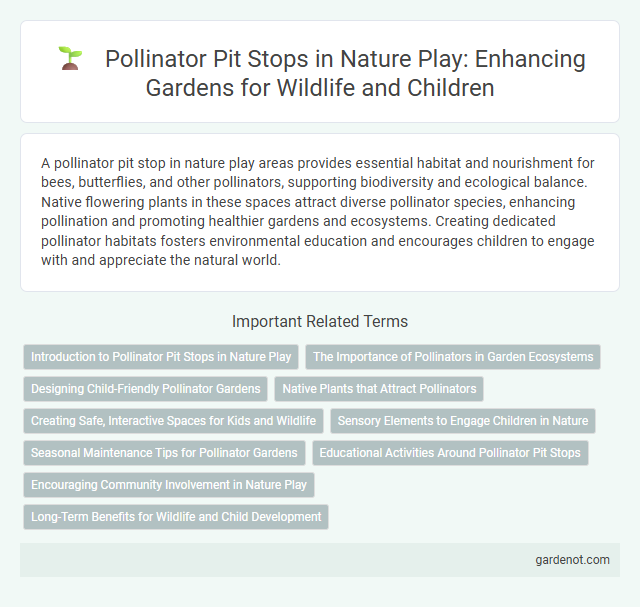A pollinator pit stop in nature play areas provides essential habitat and nourishment for bees, butterflies, and other pollinators, supporting biodiversity and ecological balance. Native flowering plants in these spaces attract diverse pollinator species, enhancing pollination and promoting healthier gardens and ecosystems. Creating dedicated pollinator habitats fosters environmental education and encourages children to engage with and appreciate the natural world.
Introduction to Pollinator Pit Stops in Nature Play
Pollinator Pit Stops are designed habitats that support essential pollinators such as bees, butterflies, and hummingbirds by providing native flowering plants and safe nesting areas. Integrating these pit stops into nature play spaces fosters environmental education, promoting awareness of pollinator roles in ecosystem health and biodiversity. These areas enhance child interaction with natural processes, encouraging stewardship and aiding local pollinator population recovery.
The Importance of Pollinators in Garden Ecosystems
Pollinator pit stops provide essential habitat and food resources that support bees, butterflies, and other pollinators critical for garden ecosystem health. These pollinators enable the reproduction of flowering plants and improve fruit and vegetable yields through effective pollination processes. Enhancing biodiversity, pollinator-friendly areas contribute to resilient ecosystems and sustainable gardening practices.
Designing Child-Friendly Pollinator Gardens
Creating child-friendly pollinator gardens involves selecting vibrant, non-toxic plants that attract bees, butterflies, and other pollinators while ensuring safe interaction for young explorers. Incorporating shallow water sources, textured paths, and diverse plant heights encourages sensory play and learning about pollination cycles. Educational signage with simple language and illustrations helps children understand the importance of pollinators in ecosystems and fosters environmental stewardship.
Native Plants that Attract Pollinators
Native plants such as milkweed, coneflowers, and bee balm provide essential nectar and pollen resources supporting pollinators like bees, butterflies, and hummingbirds. Incorporating diverse native species in a pollinator pit stop enhances habitat quality, promoting pollination services critical to ecosystem health and crop production. These plants adapt to local climate and soil conditions, ensuring sustainable growth and continuous food supply for native pollinator populations.
Creating Safe, Interactive Spaces for Kids and Wildlife
Pollinator pit stops provide safe, interactive environments where children can observe and engage with native pollinators like bees, butterflies, and hummingbirds. These spaces incorporate diverse, pollinator-friendly plants and natural habitats that support wildlife health and biodiversity while fostering outdoor learning. Designing these areas with safety features and hands-on activities encourages children's curiosity and promotes environmental stewardship from an early age.
Sensory Elements to Engage Children in Nature
Pollinator pit stops incorporate vibrant flowers and textured plants to stimulate children's visual and tactile senses, enhancing their connection to nature. Incorporating fragrant herbs and nectar-rich blossoms attracts bees and butterflies, creating an interactive learning environment about pollination. Sensory-rich features like buzzing sounds and colorful patterns engage young explorers, fostering curiosity and ecological awareness.
Seasonal Maintenance Tips for Pollinator Gardens
Seasonal maintenance for pollinator gardens includes regular pruning of native plants like milkweed and coneflowers to encourage healthy growth and flowering. Removing spent blooms and controlling invasive species helps maintain habitat quality for bees, butterflies, and other pollinators. Applying organic mulch in early spring conserves moisture and supports soil health critical for pollinator activity throughout the growing season.
Educational Activities Around Pollinator Pit Stops
Pollinator pit stops offer hands-on educational activities that teach children and adults about the vital role bees, butterflies, and other pollinators play in ecosystems. Interactive stations include flower planting, pollinator identification games, and sensory experiences that highlight pollinator behaviors and their impact on biodiversity. These activities foster environmental stewardship by connecting participants with native plants and promoting awareness of pollinator conservation strategies.
Encouraging Community Involvement in Nature Play
Pollinator pit stops create vibrant habitats that attract bees, butterflies, and other essential pollinators, fostering biodiversity in local communities. Engaging residents in planting native flowers and maintaining these spaces enhances environmental stewardship and educates about pollination's role in ecosystems. Community-driven nature play areas promote interactive learning and strengthen connections to the natural world, boosting conservation efforts.
Long-Term Benefits for Wildlife and Child Development
Pollinator pit stops provide essential habitats that support the long-term survival of bees, butterflies, and other pollinating insects, crucial for maintaining biodiversity and ecosystem health. These natural play areas encourage children to engage with nature firsthand, fostering curiosity, sensory development, and environmental stewardship from an early age. Sustained exposure to pollinator habitats enhances cognitive skills, emotional well-being, and a lifelong respect for wildlife conservation.
Pollinator pit stop Infographic

 gardenot.com
gardenot.com